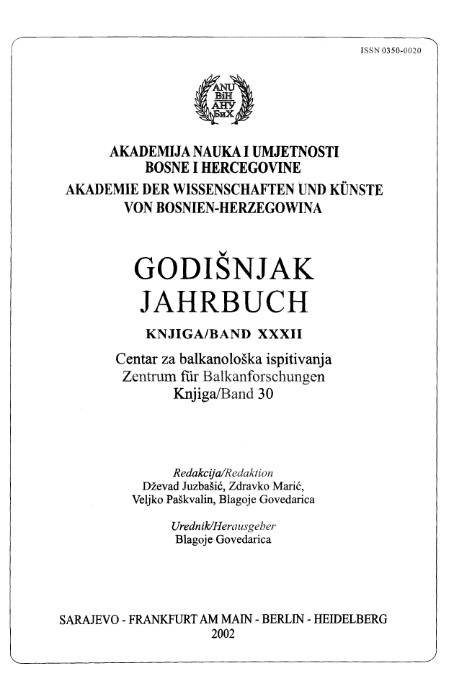O problemu načina sahranjivanja u gornjem toku reke Bosne tokom bronzanog i gvozdenog doba
On the Problem of Burial in the Upper Reaches of the River Bosnia in the Bronze and Iron Age
Author(s): Slaviša PerićSubject(s): Archaeology, Cultural history, Customs / Folklore, Ethnohistory, Ancient World
Published by: Akademija Nauka i Umjetnosti Bosne i Hercegovine
Keywords: Bronze age; Iron age; burial; river Bosnia; tumuli; middle Bosnia group; culture; pottery; necropolis; archaeology;
Summary/Abstract: Analyses of the status of investigations and previous standpoints linked to the phenomenon of burial during the last two millennia of prehistory at the upper River Bosna have shown that recent as certainments do not, under any circumstances, give a realistic picture with regard to this problem. Bearing this in mind, we believe that it is a completely unsustainable position that, for the greater part of the Bronze Age and the entire late; Iron Age on the territory of middle Bosnia group, apart, from everything else, was characterized by a continuity in skeletal burials in flat graves. Namely, in previous works which were of a synthetic nature, a wholly unjustifiably neglected fact that in a given period, most, likely during the late Bronze Age and the beginning of the late Iron Age, the inhabitants of the upper Bosna river were practicing burials in tumuli considerably. This fact particularly refers to the valley of the river Lasva, the left tributary of the river Bosna. Considering the finds from Semizovac, one should leave open the possibility that burial in tumuli was also practiced during the early Bronze Age. Taking into consideration the means of burial has brought up some other questions as well, above all, the problem of cultural stratigraphy within the mentioned chronological framework and the question of the periodization of the middle Bosnia group. In this respect, we have ascertained that the beginning of the early Bronze Age at the upper Bosna river marks the middle Bosnia variant of the Vucedol group. In that case, the so-called post-Vučedol, as is the example of phase; A on Pod by Bugojno, would in fact mark the middle Bosnia group, by which the problem of variance between the stratigraphic continuity and presumed cultural-chronological discontinuity on this site would be resolved a the same time. When considering the question of the periodisation of the middle Bosnia group, in analyzing the standpoint of the cultural-chronological character of the grave in Vratnici and the necropolis in Breza, a firm basis is created for singling out at. Least one more, or rather the VII phase of the middle Bosnia group. The older stage of this phase would coincide with the period when the bearers of the middle Bosnia group still practiced inhumation as the basic form of burial. The grave at Vratnici and the origination of the necropolis in Kamenjaci can be dated to this period (first half of the 2nd century BC.) The new stage, arid with it the end of the middle Bosnia group, would he marked by the beginning of mass production of Celtic pottery in the settlements and the transition to the practice of cremation of the deceased. If one can judge by the necropolis on the site Kamenjaca, the transition to the practice of cremation should be considered exclusively as a consequence of the arrival of Romans to Bosnia, since it is absolutely certain that they exerted a strong cultural influence on the inhabitants of the upper Bosna river even much earlier than the crushing of the Baton's uprising in 9 AD by their presence.
Journal: Godišnjak Centra za balkanološka ispitivanja
- Issue Year: 2002
- Issue No: 32
- Page Range: 179-198
- Page Count: 20
- Language: Serbian

